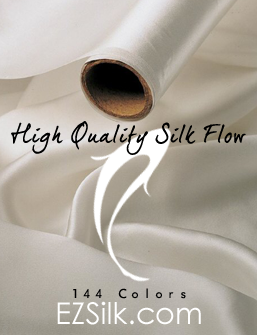Silk Related Fashion Tips
What is thread count
Thread count is a measure of quality of fabrics used for bedding.
This measure of quality looks at the fineness or coarseness of a
fabric; in this case it mostly refers to bed linens like sheets and
pillowcases. Thread count is the number of threads going each way in
one square inch of fabric.
Thread count is measured by counting the number of horizontal and
vertical threads in one square inch of fabric. Thread counts average
from lowest (80) to highest (1200). Most are usually between 180 and
300, and anything above 300 is considered higher quality.
Higher thread count means more threads, and this usually translates
into a more densely woven fabric that lasts longer and is many times
softer. Some exceptions to this rule are fabrics made of linen,
flannel, or jersey.
Fabrics like linen, flannel, or jersey are subject to low thread
count because of the type of material they are made of and the
properties of that material. For example, part of the softness of
flannel comes from its low thread count because of the material its
made from.
Ply and thickness are two factors that also affect thread count. The
ply is defined as the number of threads that are wrapped into a
single thread. Single-ply refers to the use of single threads in the
construction of a fabric. Two-ply refers to materials that twist two
threads together into a single thread, thus increasing the fabrics
thread count and creating a stronger thread. This creates a heavier,
more durable fabric.
Using finer threads often allows for softer, smoother fabrics and
more fit into a square inch. Finer thread, like silk, create a
lighter fabric, and are thus more desire able than coarser threads.
They are also more fragile, so it is important to care for them
especially well.
While thread count is important in picking your bed linens, remember
that cotton and silk are the main types of materials to judge based
on a high or low thread count. Other materials like linen, flannel,
and jersey may have a lower thread count, but this doesnt mean they
arent comfortable. Blends are also common, and often create softer
materials. Jersey-cotton blends, for example, are ideal for baby
sheets and other types of baby bedding.
When in doubt, see what feels the best. Youre best off visiting a
fabric store and exploring the many different kinds of materials to
find out how a fabric feels. Knowing what youre going to get makes
your sheet shopping experience easier and more rewarding, especially
if youre shopping online.
Silk Fabric from EZSilk.com
Silk Fabric Types:
Silk Charmeuse 19mm, 16mm
Silk Chiffion 6mm, 8mm, 12mm
Silk CDC 16mm, 19mm
Silk Organza 6mm, 8mm, 12mm
Silk Habotai (China Silk) 6mm, 8mm
Silk Shantung 17mm, 19mm
Silk Dupioni 17mm, 34mm
Silk Twill 12mm, 14mm, 16mm
Silk Duchess Satin 35mm
Silk Cotton Voile 9mm
Silk Stretch Charmeuse 16mm, 19mm
Silk Blended Novelty Fabrics
-Silk Weight: mm (It's called Mommy)
